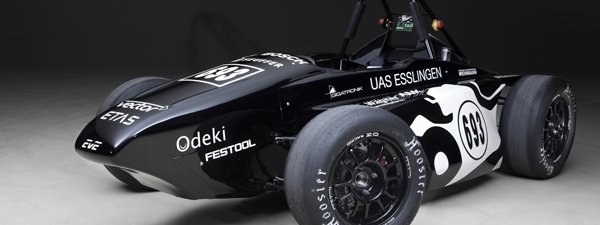Two sensors attached at the sides of the batteries measure the magnetic field generated by the flow of electrical current in order to determine the battery’s level of charge.
Engineering students at Germany’s Hochschule Esslingen University of Applied Sciences, with some help from the Fraunhofer research institute, have built an electric race car that incorporates a couple of novel solutions for battery management and electronic sensor systems.
EVE, as the new racer is called, weighs 300 kg, is powered by two 60 kilowatt electric motors, one for each rear wheel, and has two lithium polymer batteries with a combined capacity of 8 kWh. It can do 0-100 km/h in 3.6 seconds, en route to a top speed of 140 km/h. Range is 22 km.
“Electromobility as a topic is becoming ever more important. The racing car serves as a showcase for us to demonstrate novel sensor solutions as well as battery and energy management concepts,” says Klaus-Dieter Taschka, an engineer at Fraunhofer.
EVE is equipped with a vast array of sensors, including braking pressure, crash, temperature and acceleration sensors, as well as sensors that monitor the accelerator and brake pedals, speed, steering angle, wheel speed and power.
Two sensors attached at the sides of the batteries measure the magnetic field generated by the flow of electrical current in order to determine the battery’s level of charge. The contactless sensors measure both the current that flows from the battery to the motor and the current that flows back again when the vehicle brakes. The integrated sensor system is designed to eliminate disturbances and foreign magnetic fields, guaranteeing precise measurements. The system can also measure battery voltage and temperature. Data is sent to the power control unit and battery management system (BMS), which controls the charging and discharging processes.
EVE’s BMS determines the impedance spectrum of all battery cells and constantly tests whether the cells are functioning properly. This allows cells’ condition, current capacity and potential service life to be ascertained and running times to be predicted more accurately.
“Until now, a battery system was able to provide only as much energy as was available in its weakest cell. The energy stored in other cells remained unused,” explains Fraunhofer’s Dr Peter Spies. “Our BMS has an active cell balancing system that moves energy between stronger and weaker cells. This means that all cells share the load equally, allowing the maximum capacity of the battery as a whole to be utilized.”
The new technology will soon have a chance to prove itself on the track. This year, EVE will be in the lineup for the Formula Student races in Italy, Spain and the Czech Republic.




























































































